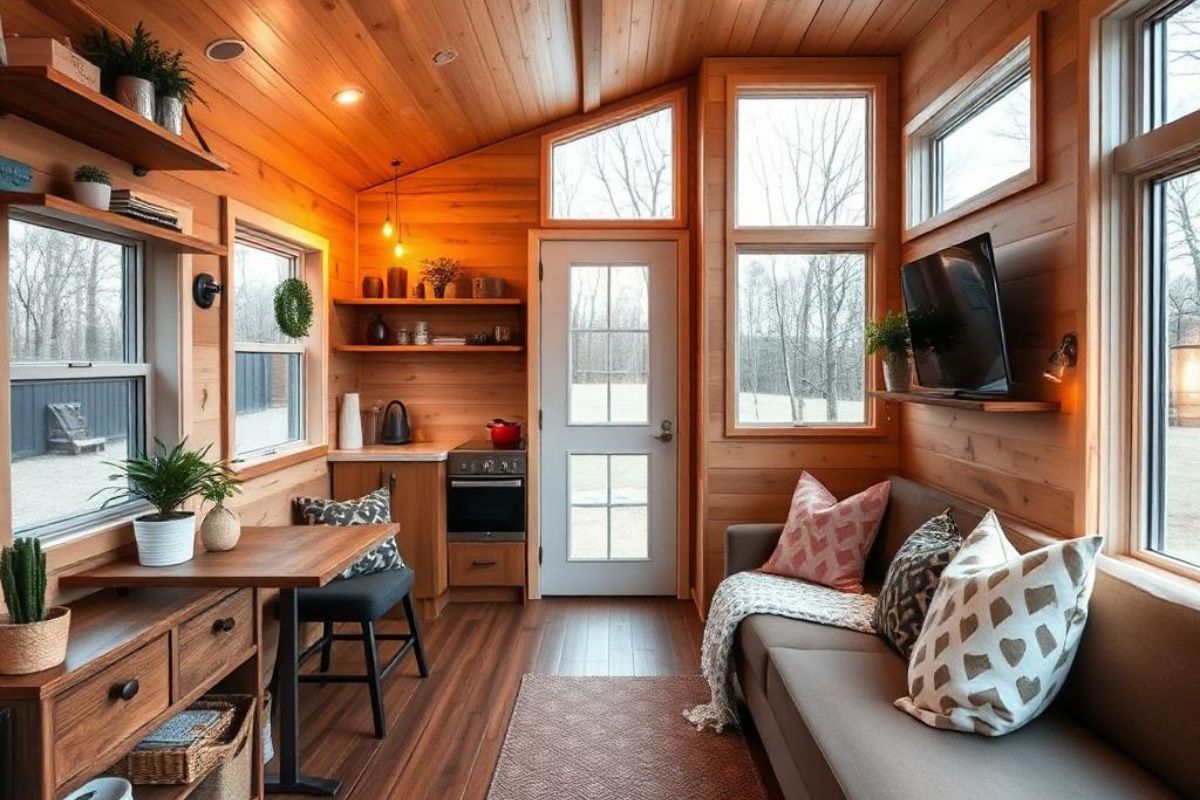To live off-grid in a tiny house, start by choosing a location with access to water, food, and sunlight for energy. Design your space efficiently using multifunctional furniture and sustainable materials. Harness renewable energy through solar panels or wind turbines. Implement effective water collection and filtration systems. Adopt eco-friendly waste management practices like composting toilets. You'll also want to contemplate growing your own food. Stick around for more tips to make your off-grid experience even better!
Key Takeaways
- Choose a suitable location with access to water, food, energy sources, and familiarity with zoning laws to ensure legal compliance.
- Design your tiny house with space-saving furniture and high-quality insulation to maximize efficiency and minimize energy consumption.
- Harness renewable energy by installing solar panels, wind turbines, or micro-hydro systems, and consider battery storage for consistent power supply.
- Implement effective water collection and filtration systems, including rainwater harvesting and multi-stage filtration for safe drinking water.
- Utilize eco-friendly waste management solutions, such as composting toilets and greywater recycling, to reduce your environmental footprint.
Choosing the Right Location for Your Tiny House
When you're choosing the right location for your tiny house, what factors should you consider? First, think about access to essential resources like water, food, and energy. You'll want to be near a water source and have options for growing your own food. Next, consider the climate. Make sure it suits your lifestyle and construction materials. Zoning laws and land regulations also play a vital role; familiarize yourself with local codes to avoid legal headaches. Additionally, assess the location's proximity to community services, like healthcare and emergency services. Finally, don't forget about your personal preferences—scenic views, privacy, and a sense of community can greatly enhance your off-grid living experience. Choose wisely, and your tiny house life will thrive.

Designing for Efficiency and Sustainability
To create an efficient and sustainable tiny house, you'll want to prioritize smart design choices from the start. Focus on space-saving furniture that can serve multiple purposes, like a fold-out desk or a Murphy bed. Opt for high-quality insulation to minimize heating and cooling needs, ensuring your home stays comfortable year-round. Use large windows for natural light and ventilation, reducing the need for artificial lighting. Incorporate rainwater collection systems and greywater recycling to maximize water efficiency. Choose sustainable materials—think reclaimed wood or bamboo—to lower your environmental impact. Finally, plan for adequate storage to keep your space organized and clutter-free. These design principles not only enhance your tiny house's functionality but also contribute to a more sustainable lifestyle.
Harnessing Renewable Energy Sources
As you embrace off-grid living in your tiny house, harnessing renewable energy sources becomes vital for an independent and sustainable lifestyle. Solar panels are a popular choice; they convert sunlight into electricity efficiently. You can start small with a few panels, gradually expanding as your energy needs grow. Wind turbines are another option, especially in windy areas, generating power even on cloudy days. Don't forget about micro-hydro systems if you have access to a stream; they provide a consistent energy source. Battery storage is important too, as it allows you to store excess energy for use during low production times. By diversifying your energy sources, you can guarantee a reliable and sustainable power supply while minimizing your environmental impact.

Water Collection and Filtration Systems
After establishing a reliable energy source, the next step in off-grid living is guaranteeing you have access to clean water. One effective method is rainwater harvesting, where you collect rainwater from your roof using gutters and downspouts. Make certain to install a storage tank to hold your collected water.
For filtration, a multi-stage system works best, starting with a first flush diverter to remove debris. Then, use a combination of sediment filters, activated carbon filters, and UV purifiers to guarantee the water's safety.
Regularly check for contaminants, and consider keeping a backup supply, like bottled water. By setting up a solid water collection and filtration system, you'll enjoy peace of mind while living off-grid in your tiny house.
Waste Management Solutions for Off-Grid Living
While living off-grid in a tiny house offers many freedoms, managing waste effectively is essential for maintaining a healthy environment. Start by choosing a composting toilet, which breaks down human waste into compost. It's odorless and eco-friendly when done right. You'll also want to set up a greywater system to recycle water from sinks and showers. Use biodegradable soaps to minimize environmental impact. For solid waste, create a designated area for composting food scraps and yard waste, turning them into valuable soil. Finally, practice recycling and upcycling to reduce what goes to landfills. By implementing these waste management solutions, you'll contribute to a sustainable lifestyle while enjoying your off-grid experience.
Growing Your Own Food: Gardening Tips
Growing your own food can be one of the most rewarding aspects of off-grid living in a tiny house. To start, choose a sunny spot for your garden, as most vegetables thrive with at least six hours of sunlight daily. Raised beds can maximize space and improve drainage. Opt for easy-to-grow crops like tomatoes, lettuce, and herbs, which require less maintenance. Incorporate companion planting to naturally deter pests and boost growth. Don't forget to invest in quality soil and organic fertilizers to nourish your plants. Finally, keep a watering schedule to guarantee your garden receives consistent hydration. With patience and care, you'll enjoy fresh, homegrown produce right at your doorstep, enhancing your off-grid lifestyle. Happy gardening!
Maintaining Comfort and Safety in Your Tiny Home
To maintain comfort and safety in your tiny home, it's essential to prioritize effective insulation and ventilation. Insulation helps regulate temperature, keeping you warm in winter and cool in summer. Choose materials like spray foam or wool for ideal results.
Also, don't underestimate the importance of good ventilation. Install windows that open and consider a small exhaust fan to prevent moisture buildup and improve air quality.

Additionally, invest in a reliable heating source, such as a propane heater or wood stove, making sure it's properly vented.
For safety, have smoke and carbon monoxide detectors installed. Regularly check your electrical systems and confirm your tiny home is anchored securely. By taking these steps, you'll create a cozy, safe environment for off-grid living.
Conclusion
Living off-grid in a tiny house is an empowering journey that promotes sustainability and self-sufficiency. By choosing the right location, designing efficiently, and harnessing renewable energy, you can create a comfortable and eco-friendly space. Implementing effective water and waste management systems, along with growing your own food, enhances your off-grid lifestyle. Embrace these tips, and you'll not only thrive in your tiny home but also contribute positively to the environment, making each day a rewarding adventure.






Share: